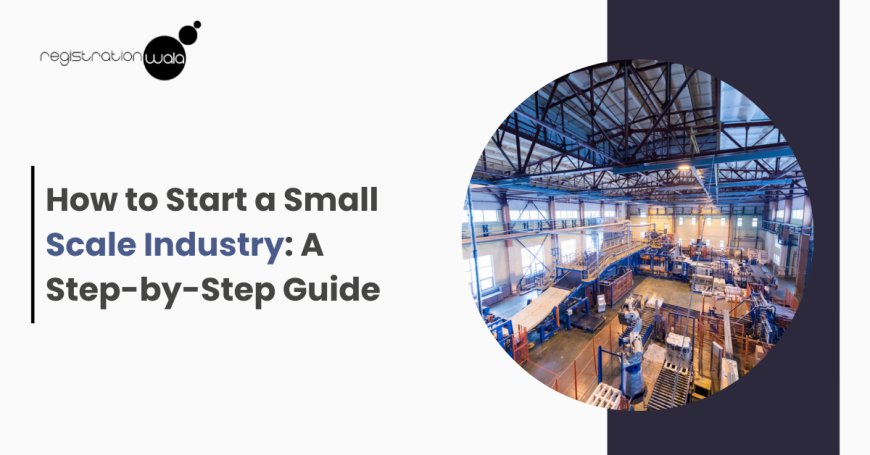How to Start a Small Scale Industry: A Step-by-Step Guide

Starting a small-scale industry can be an empowering and rewarding journey for entrepreneurs looking to make a mark in their industry without massive investment. With the right planning, strategy, and knowledge, you can navigate this path successfully. Here’s a step-by-step guide on how to start a small-scale industry.
What Are Small-Scale Industries?
Small-scale industries (SSIs) are manufacturing or service-oriented businesses that operate with a smaller workforce and lower capital requirements than large-scale industries. Typically, these industries focus on local or niche markets, producing goods or services tailored to a particular customer base. Examples of small-scale industries include food processing, textiles, handicrafts, furniture making, and more.
Step-by-Step Guide to Starting a Small-Scale Industry
Step 1: Conduct Market Research
Before starting, you need to understand the demand for your product or service. Market research involves analyzing your target audience, assessing competitor activities, and identifying potential gaps in the market. Effective research ensures that you develop products or services that will appeal to your audience and have a competitive edge.
Step 2: Choose a Suitable Business Idea
Based on your market research, choose a business idea that aligns with your skills, resources, and market needs. Look for niches or products that are in demand but have limited competition. Some popular small-scale industry ideas include organic food products, handmade crafts, and eco-friendly goods.
Step 3: Create a Business Plan
A well-structured business plan outlines your goals, operational strategy, marketing approach, and financial projections. It serves as a roadmap for your business and is essential for securing loans or investments. Include key sections like your product or service description, market analysis, financial projections, and funding requirements.
Step 4: Arrange Financing
Small-scale industries require some level of capital to cover expenses like equipment, materials, and operational costs. Options include self-financing, applying for small business loans, or exploring government grants or subsidies for small businesses. Make sure to have a solid financial plan to manage cash flow effectively.
Step 5: Select a Business Location
Your business location plays a critical role in operational success. Look for a location that’s accessible to your target market, suppliers, and workforce. Additionally, ensure the location is affordable and adheres to industry-specific zoning regulations or permits.
Step 6: Register Your Business and Obtain Licenses
Registering your business is essential for legal compliance and gaining customer trust. Choose a business structure (like sole proprietorship, partnership, or private limited company) and complete the necessary registration process. Additionally, check for industry-specific licenses or permits that may be required for your small-scale industry.
Step 7: Set Up Production Facilities
Once your location is secured, start setting up your production facilities. This includes purchasing equipment, setting up production lines, and ensuring a streamlined workflow. For small-scale industries, efficient use of space and resources is key to maintaining lower operational costs.
Step 8: Hire and Train Staff
Hiring a skilled and motivated workforce is essential for your business’s success. In small-scale industries, employees often wear multiple hats, so prioritize flexibility and adaptability in your hiring process. Provide adequate training to ensure they can operate machinery, understand quality standards, and handle customer interactions.
Step 9: Develop a Marketing Strategy
Even the best products need effective marketing to reach customers. Utilize both traditional and digital marketing channels to create brand awareness. Focus on building a brand that resonates with your target audience through social media, SEO, local advertising, and networking.
Step 10: Monitor and Grow Your Business
Once your small-scale industry is operational, track its performance regularly. Use metrics like sales volume, profit margins, and customer satisfaction to assess areas for improvement. Continuously seek ways to innovate and expand, whether by introducing new products, exploring new markets, or increasing production capacity.
Benefits of Starting a Small Scale Industry
Small-scale industries offer several advantages, including lower startup costs, flexibility, community engagement, and potential for growth. SSIs can also benefit from various government schemes, tax breaks, and incentives aimed at promoting small businesses and local employment.
Conclusion
Starting a small-scale industry requires careful planning, commitment, and resilience. With a clear strategy and effective execution, you can successfully launch and grow a small business that not only meets market needs but also contributes to local economic development. Remember, patience and adaptability are key to overcoming the challenges that may arise along the way.
Also Read: Everything you need to know about RWA
